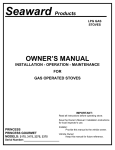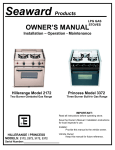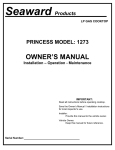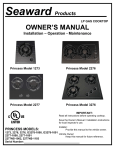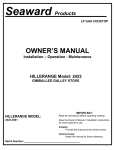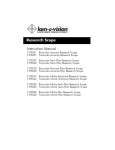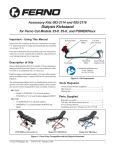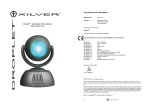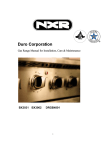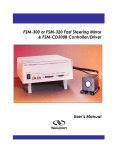Download Seaward PRINCESS GOURMET SERIES Owner`s manual
Transcript
Rev. 20110629 Seaward Products LPG RANGE OWNER’S MANUAL PRINCESS / PRINCESS GOURMET SERIES INCLUDES 2 & 3 BURNER CONFIGURATIONS Model Number________________________________ Serial Number ________________________________ IMPORTANT SAFETY INSTRUCTIONS I WARNING Seaward Products recommends that a qualified person or electrician install this product. Seaward Products accepts no responsibility or liability for damage to equipment, injury, or death that may result from improper installation or operation of this product. When using electrical appliances, basic safety precautions to reduce the risk of fire, electrical shock, or injury to persons should be followed. 1. READ ALL INSTRUCTIONS THOROUGHLY BEFORE USING THIS GAS RANGE. 2. Save the Owner’s Manual/Installation instructions for local inspector’s use. INSTALLER: Provide this manual to the vehicle owner. VEHICLE OWNER: Keep this manual for future reference. 3. NEVER USE FLAME TO CHECK FOR LEAKS. LPG is heavier than air and if allowed to settle or accumulate, and if ignited, IT WILL CAUSE AN EXPLOSION!! 4. Install or locate this range only in accordance with the provided installation instructions. 5. Use this range only for its intended use as described in this manual. 6. As with any appliance, close supervision is necessary when used by children 7. THE FEATURES COVERED IN THIS MANUAL ARE FOR VARIOUS MODEL RANGES. PLEASE DISREGARD PORTIONS PERTAINING TO FEATURES THAT ARE NOT ON YOUR PARTICULAR MODEL RANGE. 1 Rev. 20110629 LPG FUEL TANK INSTALLATION REFERENCE: STANDARD #A-1 AMERICAN BOAT & YACHT COUNCIL 3069 SOLOMON’S ISLAND ROAD EDGEWATER, MD 21037 LPG TANK WITH REGULATION SYSTEM 1. Locate the tank and regulator on deck, cabin top or in a vapor tight compartment, insulated from the hull interior and protected from climatic extremes by a housing vented to the open air. The vent should be at the bottom of the compartment so that if the LPG should leak from the system, it will drain overboard NOTE: LPG is heavier than air and if allowed to settle or accumulate, and if ignited, IT WILL CAUSE AN EXPLOSION!! 2. The LPG tank should be securely bolted down by the tank feet and in the position in which the tank was designed. LPG is a two-phase (liquid/vapor) fuel and only vapor withdrawal from the tank is safe. Liquid withdrawal from the tank could be dangerous. 3. IMPORTANT: The LPG tank valve outlet fitting and regulator system nut, by law, must have left-hand threads. The nut is so marked with a slot. 4. The LPG tank valve outlet fitting does not require pipe dope or Teflon tape and should be attached to the regulation system nut dry and clean to keep foreign materials out of the system. When assembling the regulation system, use a high quality sealant only on all male pipe threads. 5. The regulator must have a 0 to 300 psi pressure gauge located on the tank pressure side of the regulator. 6. If the LPG tank is to be located on deck or exposed to water spray, point the regulator system so that water cannot run into the regulator vent port located just above the LPG outlet connection, or into the body of the pressure gauge. 7. Affix the caution label supplied with the stove in the immediate vicinity of the tank where the label will be plainly visible. (Refer to ABYC Standard #A-1) 8. The LPG supply line should be U.L. listed hose with machine-crimped fittings. A single continuous hose without couplings or tees is strongly recommended. Keep the number of fittings to an absolute minimum. Every connection is a potential leak! 9. Run the hose from the LPG regulation system to the appliance with 6 inch minimum radius turns, so the hose does not kink, cutting off the fuel supply to the appliance. Note: Fuel pressure is less than ½ psi. 10. Keep hose away from heat or abrasion. Use plastic ties or clamps to secure the hose to the boat structure or bulkhead. 2 Rev. 20110629 SUMMARY FOR CHECKING LPG SYSTEM AND LPG APPLIANCE 1. After the LPG tank has been installed, the regulation system connected, the hose run and connected to both the appliance and the regulator, slowly crack open the LPG tank valve and observe the pressure gauge on the regulation system. The gauge should read approximately 110 psi at 70° F. (Higher if warmer, or lower if cooler atmospheric temperature.) 2. Close the LPG tank valve and observe the pressure gauge. It should hold a constant pressure reading. If you can detect a falling in pressure over a 3 minute period of time, there is a leak. LEAKS CAN BE DANGEROUS!! a. If a leak occurs, check all appliance burners to see if in “Off” position. b. Make sure the oven control is in “Off” position. c. Check all fittings with a soap and water solution. NEVER USE FLAME TO CHECK FOR LEAKS. 3. If you cannot find the leak, contact Seaward Products promptly. 4. PRESSURE GAUGE: The primary function of the pressure gauge at the regulator is to check for leaks, but it may also be helpful in determining the fuel level in the tank. When the liquid propane in the tank nears the empty state, the gauge will indicate a low pressure. Since the vapor pressure of the propane varies with the ambient and the temperature, using the gauge as a fuel level indicator may require some experience. In general, when the gauge shows below 40 psi, you should consider refilling the tank. SPECIAL NOTE ABOUT YOUR LPG REGULATOR: It is recommended that only a high quality LPG regulator be used with any of Seaward Products LPG appliances. It is imperative that the regulator be set at 11-inch water column so that the oven operates correctly, and the 3 Rev. 20110629 flame height on the top burners cooks efficiently. If the regulator pressure is greater than 11inch water column, the flame can impinge on the top burner bowl causing discoloration on stainless bowls and may chip the porcelain on the porcelain bowls. OPERATING INSTRUCTIONS SUMMARY FOR A LPG SYSTEM 1. Close tank valve immediately in any emergency. 2. Be sure all appliance valves are closed before opening tank valve. 3. Close tank valve whenever appliance is not in use. 4. Test system for leakage at least twice a month and after any emergency in accordance with the following procedure: With appliance valves closed, and the tank valve open, note pressure on the gauge. Close cylinder valve. If the pressure drops, as indicated on the gauge, this tells you there is a leak in the system. Locate leakage by application of a liquid detergent or soap and water solution to all connections. After leak has been repaired, recheck system by repeating the above test. If leak cannot be repaired, close the tank valve immediately and do not use this system. Remember LPG is heavier than air and if allowed to reach bilges, machinery space or other enclosed spaces, it can be extremely dangerous. 5. It is always a good idea to have an approved ABC type fire extinguisher in the galley area. LPG RANGE WITH IGNITER TO LIGHT TOP BURNERS WITH SAFETY SYSTEM 1. Push in knob and turn to “IGN” (Ignite) position. 2. Hold knob in and press the “BURNER IGNITE” button. 3. Hold knob in for 5 to 10 seconds until the thermocouple is hot. This will activate the safety magnet. 4. Release knob and set to desired setting. If the flame does not stay on, the thermocouple is not hot enough. (Repeat Steps 1-3). SPARK FROM THE ELECTRODE HAS TO CUT ACROSS THE GAS TO IGNITE READILY. IF THE SPARK IS JUMPING BELOW THE BURNER PORTS MAKE SURE THE POINT OF THE ELECTRODE IS CLEAN SO THAT THE SPARKS WILL JUMP ABOVE THE PORTS. 4 Rev. 20110629 [TO LIGHT OVEN BURNER WITH SAFETY SYSTEM 1. Turn the thermostat knob from the "OFF" to the “IGNITE" position. 2. With the knob in the “IGNITE” position push-in and hold knob. 3. With the knob being held in, push the “BURNER IGNITE” button. 4. After the oven burner is lit, keep the knob pushed-in for 10 to 15 seconds. 5. Release knob. Now set the thermostat knob to desired setting. GIMBALED MODELS – 2- & 3- BURNERS 1. It is important that the following minimum clearances from combustible materials be adhered to when installing your gimbaled range 2-BURNER MODEL: Side – 7” minimum as measured from the center line of the closest burner head. Rear - 9” minimum as measured from the center line of the closest burner head. Top – 24” minimum to overhead cabinets, shelves or any other combustible material. 3-BURNER MODEL: Side – 5-1/2” minimum as measured from the center line of the closest burner head. Rear - 7” minimum as measured from the center line of the closest burner head. Top – 24” minimum to overhead cabinets, shelves or any other combustible material. 2. Make a cardboard template the same size as the side view of the range. Punch a hole at the gimbal location the size of the gimbal, and swing the appliance template in the appliance cut-out location in the boat on your finger. By allowing a swing approximately 15° to 20° before interference with the hull or boat structure, the gimbal point can be located. Mark the point. Make certain that after the gimbal point is determined, the installation matches or exceeds the minimum clearance in paragraph #1. It is important that the oven vent be completely clear so that burned gases can discharge to the open air. If this vent is blocked, poisonous gas could be produced. 3. Locate the companion pieces to the gimbals and install the appliance. 4. For safety, Seaward Products gimbaled appliances are designed with a sliding bolt type lock. The sliding bolt should lock into an adjacent cabinet or bulkhead to prevent the appliance from swinging in rough weather. I CAUTION: The appliance center of gravity will also shift from the gimbal location when pots are not balanced on the appliance or when the appliance door is open. 5. Connect the LPG fuel supply hose fitting to the brass fitting on the appliance manifold and on the regulation system. Wrench tighten the fitting to the connection on the appliance. DO NOT use pipe dope or Teflon tape. 5 Rev. 20110629 6. Check all gas connections for possible leaks. Turn the valves on your range to their “OFF” position. Open valve on gas supply tank. Using a strong soap and water solution (1 part liquid soap and 1 part water), check each gas connection one at a time by brushing the soap and water solution over the connection. Presence of bubbles will indicate a leak. Tighten fitting and recheck for leaks. DO NOT USE OPEN FLAME FOR CHECKING GAS LEAKS. 7. Place burner grates in place with the clips provided. An instruction sheet is provided for the grate clips. These grate clips will hold the grate in place while under way. 8. Light the burners for testing. 9. The appliance is now ready for use. Sometimes the burners will not ignite immediately and seem to “blow” slightly when they do ignite. This is usually due to the presence of air in the gas lines, which will clear itself within seconds. 6 Rev. 20110629 7 Rev. 20110629 GIMBAL INSTALLATION 2-BURNER RANGE 8 3-BURNER RANGE Rev. 20110629 EXPLODED VIEW AND PARTS LIST OF ALL GAS RANGES WITH OVENS MODELS: 2174, 3174, 2374, 3374 & 2175, 3175, 2375, 3375 Replacement Parts Replacement parts listed herein may be ordered through Seaward Products, Seaward Distributors and Dealers, or Dealer’s Authorized Service Centers. All parts will be shipped at prevailing prices. When ordering repair parts, please give the following information: (1) (2) (3) (4) Model number Serial number Part number Part description The model number and serial number of the range can be found on the rating plate located on the back panel. For the Authorized Service Center nearest you, please contact Seaward Products. ITEM # 1 2 3 4 5 6 7 8 9 10 11 12 13 PARTS LIST FOR 2-BR AND 3-BR MODELS PART # DESCRIPTION 73420 GRATE, BLACK PORCELAIN “xx75” ONLY 75710 BURNER CAP 75711 BURNER BASE 75712 BURNER BODY 80777 SPILL BOWL 72257 2-BR MAIN TOP, STAINLESS STEEL 1 72251 3-BR MAIN TOP, STAINLESS STEEL 1 75703 THERMOSTAT 2/3 75717 TOP BURNER VALVE 75735 2-BR FACEPLATE 1 75736 3-BR FACEPLATE 2-BR PUSH BUTTON IGNITION 1 75659 3-BR PUSH BUTTON IGNITION 2/3 73594 KNOBS 1 80781 OVEN BURNER ASSEMBLY 80010 BLACK GLASS OVEN DOOR 1 80011 STAINLESS STEEL OVEN DOOR 1 73514 GRATE, 3-BR FULL “xx74” ONLY 1 73515 GRATE, 2-BR FULL “xx74” ONLY QTY 2/3 2/3 2/3 2/3 2/3 9 Rev. 20110629 CARE AND CLEANING Regular cleaning with a soft cloth and a warm detergent solution is generally enough to keep your oven clean and beautiful. This is done when the range is cool. Use a dry cloth or paper towel to clean splatters and spills when surfaces are warm. PORCELAIN ENAMEL - Porcelain enamel is glass fused on steel at very high temperatures. It is not extremely delicate, but must be treated as glass. Sharp blows, radical changes in temperature, etc., will cause the enamel to chip or crack. Some foods contain acid which will dull the finish of enamel. Vinegar, lemon juice, tomatoes, and milk are a few. To avoid this happening, simply wipe surface clean immediately when any food is spilled on the enamel. Remember, the surface is glass and must be given consideration in cleaning. Steel wool pads and coarse gritty cleansing powders or chemical grease remover will do a good job and yet not harm the finish. GLASS SURFACE - The extra large glass window is built to stay FOG–FREE. To keep it clean, just wipe with a moist, soft cloth and dry. CAUTION: Do not clean the window with water while the oven is warm. The glass is strong, but radical heat changes or a sharp blow will crack it. Use care in cleaning. NOTICE: When the unit is in operation, the outside surfaces will become hot and care must be taken to avoid contact with panel surfaces. Handles and knobs will remain comfortable to the touch. CHROME AND STAINLESS STEEL - The best way to clean metal surfaces on your range is to wipe them with a damp cloth, then dry thoroughly. Stubborn spots caused by spillage and discoloration from heat may be removed by the use of lemon juice, vinegar, or chrome polish. Care must be used to keep these away from porcelain enamel surfaces. NEVER use coarse cleansers, steel wool scouring pads or metal brushes to clean chrome. These will make deep scratches on the chrome. The scratches cannot be removed. USE OF ALUMINUM FOIL- (1) IN THE OVEN – Do not use aluminum foil in your oven to cover racks or oven bottom. (2) IN THE BROILER – Aluminum foil may be used to line the bottom part of the two-piece broiler pan, but if foil is placed over the slotted broiler tray, care must be taken to slit the foil at each slot so that drippings and excess grease can drain in the pan below. INSIDE OVEN AND BROILER - Racks and broiler pan may be removed and cleaned in your sink with other cooking utensils. The inside surfaces of the oven is porcelain enamel and should be cleaned by the method given in the enamel section. The Capillary Tube in the oven is not removable. This senses oven temperature and is perhaps the most fragile part of your range. Be sure to gently wipe off this tube after using an oven spray cleaner, the cleaner can “build up” on the tube and may cause a false temperature reading. 10 Rev. 20110629 LIMITED TWO YEAR WARRANTY SEAWARD PRODUCTS warrants the products delivered will be: A. Free from (1) encumbrances and (2) defects in material and workmanship under the normal use and service. B. Will meet applicable specifications and descriptions at time of delivery to BUYER. The obligation of SEAWARD under this warranty is limited to the repair, rework, or replacement, at SEAWARD’S option, any part or component thereof, which examination discloses to our satisfaction to have been nonconforming or defective. SEAWARD, after establishing customer’s purchase date and determining problem to be under warranty, will either repair the product at their factory or authorized service center and allow labor and parts for two (2) years from purchase date. Transportation charges are the responsibility of the customer. Conditions not covered under warranty are: (1) Porcelain enamel (2) Glass (3) Routine maintenance that may be required The foregoing warranty and condition shall apply to any repaired, reworked, or replaced products, part or component supplied by SEAWARD and shall in no event be liable to BUYER or BUYER’S customers for any incidental or consequential damages, or loss of use, or other losses, however occasioned. Implied warranties of merchantability and of the fitness of the product for any purpose are warranted for a period of two years on parts and labor. SEAWARD makes no warranties, expressed or implied after that time. Some states do not allow limitation on how long an implied warranty lasts or for the exclusion or limitations of incidental or consequential damages, therefore, the above limitations may not apply to you. This warranty is extended to the original purchaser only, unless purchased for purpose of resale. This warranty gives you specific legal rights, and you may also have other rights which vary from state to state. Seaward Products Seaward Products GR_2+3 ALL 20110629 3721 Capitol Avenue Whittier, CA 90601-1732 USA Tel. (562) 699-7997 Fax. (562) 699-0908 www.seawardproducts.com 11











